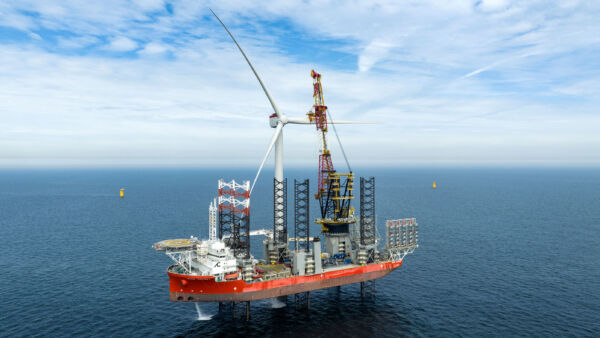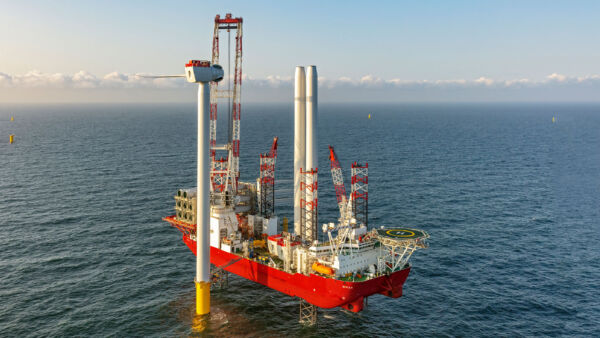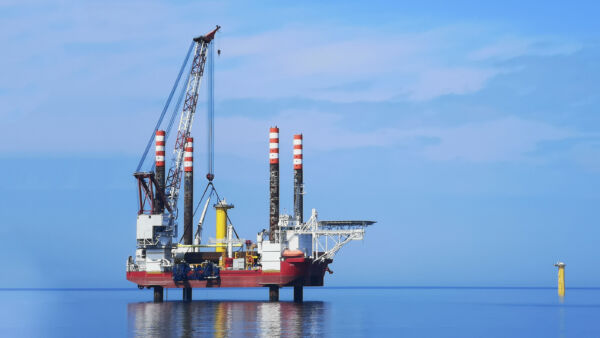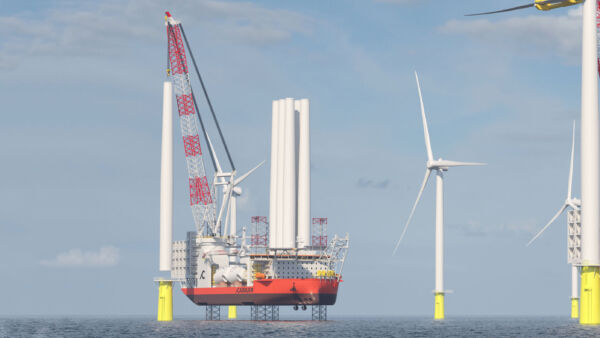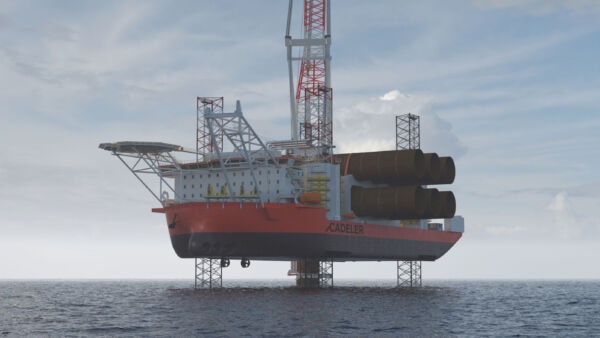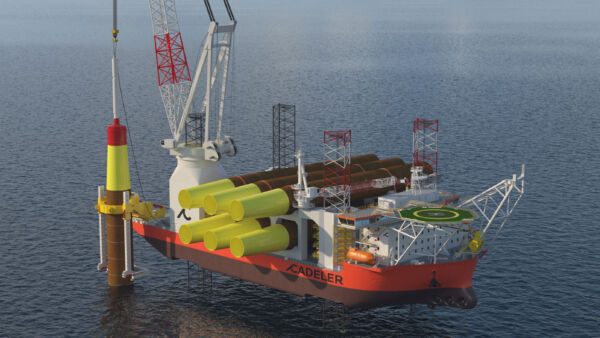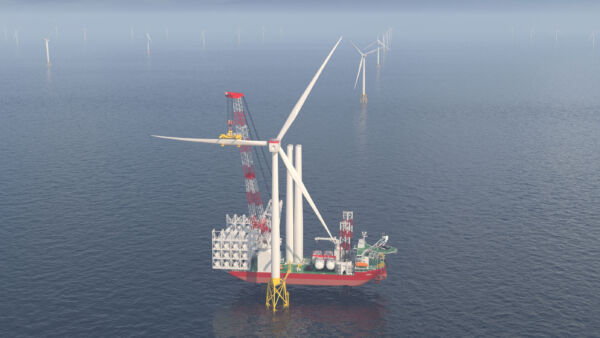Our two highly adaptable and well-maintained wind turbine installation vessels - the O Class vessels - provide a safe, efficient, and reliable solution for the installation, maintenance, and decommissioning of windfarm projects. Their advanced specifications set the new industry benchmark for vessel transit speed, lifting capability, DP station keeping and jacking speed, offering a significantly improved operating weather window. They are fitted with high-quality equipment, supported by advanced preventative maintenance systems, and incorporate a significant level of operating redundancy. Safety is enhanced through a 6-leg design that allows them to operate even on sites with the most challenging seabed conditions.
With a large cargo area and high-capacity deck loading, our vessels offer considerable flexibility in the transport and installation of turbines and foundations of all types and sizes that are currently on the market. They are operated with the maximum level of precision by experienced crews and offer highly functional facilities for the crews onboard.
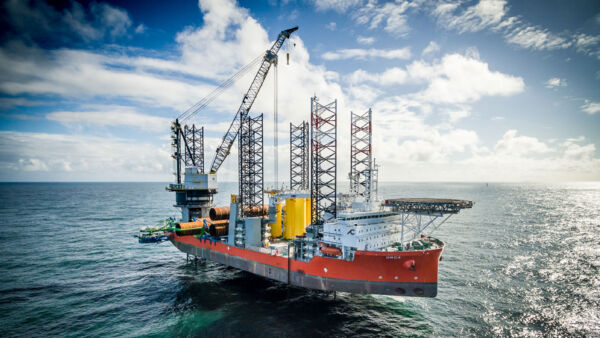
Wind Orca
Our O Class vessels: Wind Osprey and Wind Orca
New cranes - lifting the new generation of turbines
As wind turbine generators (WTGs) increase in megawatt (MW) output and physical size, so does demand for even larger cranes with higher specifications.
Crane installation works were completed at the start of 2024 on our O Class vessels to ensure they are capable of handling the next generation of turbines.
The new main cranes each have a lifting capacity of 1,600 t at a radius of 40 meters. The main hook can reach 160 meters above the main deck and is a substantial upgrade from the previous vessel cranes.

The deck at stern is reinforced to accommodate transversal stowage of WTG blades on a dedicated seafastening structure.
Several electrical socket outlets (50/60Hz) across the deck allow the client to connect their equipment directly to the vessel power system.
The total deck space is 4,300 m2 and has up to 15 tonne/m2 deck loading capacity.
WTG Intake
Up to five 8-10MW
Up to four 11-14MW
Up to three 14MW+
This equipment enhances the manoeuvrability of the vessel and provides a high level of redundancy for safe operations in port as well as offshore.
Azipod Stern Thruster: 4 x 3.4 MW
Bow Retractable Azimuth Thruster: 2 x 2.2 MW
Bow Tunnel Thruster: 2 x 2.2 MW
The jacking system lifts the vessel out of the water, and keeps the vessel completely levelled during installation of the turbine components.
The active pre-loading capacity is up to 8,820 tonnes per leg (at jacking house), which ensures a stable foundation for offshore operations in challenging conditions. The jacking speed is up to 2.4 m/min. for maximised operational up-time, enhancing the effective installation time available for our clients. The electric high-speed Rack & Pinion state of the art jacking system calls for very limited maintenance, leading to optimised vessel up-time. The payload jacking is up to 11,000 tonnes. This ensures that clients are able to carry more product per load and saves costs by reducing the number of trips. The system comes with a high level of built-in redundancy.
Legs
The six legs provide increased stability
during jacking operations and offer redundancy at challenging sites with
punch-through or seismic risk. They are 105 m in length and can operate
in water depths in the range of 8 to 60 metres.
Type: 6 sets of 3-chord truss type
The main diesel engines put the whole vessel in motion, without their power, no installation would be possible. They are also biggest contributor to the carbon footprint of the vessel. As improving the future of the planet is one of the reasons why we are in the offshore renewables business, Cadeler is also assessing Energy Efficiency and Carbon Reduction measures to improve performance and reduce our own impacts.
Type: 8 x MAN Doosan 9L27/38
Maximum speed: 13 knots
Service speed, fully loaded: 10-11 knots
Fitted with efficient jetting systems to break any suction effect from the soil. The spudcan design is one of the most robust on the market, providing reliability in all types of soils. When sailing, they are fully retractable at keel level.
Designed with a Rack Phase Difference (RPD) monitoring alarm which ensures safe jacking operations at all times.
The spudcans have performed across some of the most challenging offshore sites in Europe e.g. with maximum leg penetration values of 22m, high leg extraction forces, and the deepest bottom fixed wind farms (Seagreen OWF)
Type: Built-in hexagonal spudcans
Diameter: Approx. 12 metres each
Preload value: Up to 10,000 tonnes (at spudcan base)
The vessel has 111 single cabins with en-suite bathrooms. Approximately 70 of these cabins are available to clients and their personnel. The rest are reserved for the Master, officers, the vessel engineers, the lifting team, including the crane operators, and the deck crew. The crew normally work four weeks on and four weeks off, which is why the vessel is built to offer a high level of comfort while they are working at sea.
The vessel is equipped with:
Deck Office
2 Conference Rooms
3 Multi-use Offices
Cafeteria with 70 seats, serving 3 daily meals
2 Day Rooms
Fitness Centre with sauna
2 TV lounges/cinemas
Internet
It is from here that the Master and officers manoeuvre the vessel with high precision, ensuring smooth transits between harbours and wind farms, precise offshore positioning of the vessel and safe jacking operations.
DP2 Vessel
Positioning tolerance: +/-1.0 m and +/-1 degree
EIVA positioning system
Real time jacking parameters monitoring (water depth, leg penetration, pre-load value, etc.)
Accessed from the 9th deck, the helideck is used for vessel access by our own crew and client personnel when the vessel is offshore, ensuring safe and timely on and offboarding of people while minimizing downtime during projects execution.
Diameter: 22 metres
Allowable helicopter weight: 12.8 tonnes
Certification: CAP437
As offshore wind turbines continue to scale up, from 2024 onwards, the upgraded crane will provide the O-class with a substantial increase in lifting capacity. The crane design will enable installation of next-generation wind turbines while maintaining the vessel’s exceptional capacity to jack up on difficult sites and weather treacherous offshore conditions.
The main crane’s lifting capacity is 1,600 metric tonnes at a radius of 40 metres, with a main hook height of 160 metres above the main deck.
Manufacturer: NOV-GustoMSC
Auxiliary Deck Cranes
The vessel has two auxiliary deck cranes.
Crane 1 is located starboard side, forward of the centre leg, and is primarily used for port and offshore logistics and has a lifting capacity of 35 tonnes @ R30 m and 25 tonnes @ R40 m
Crane 2 is located starboard side, forward of the main crane, and is used for on-deck equipment handling of tower sea-fastening and offloading equipment/tools to the foundation; Crane 2 has a lifting capacity of 16.5 tonnes @ R45 m
The self-deployable telescopic gangway is located at starboard side, forward of the main crane, and provides offshore technicians a safe and firm platform for access to the foundation/wind turbine from the jacked-up vessel. It includes pass through electrical services at the tip end to provide power directly to the wind turbine from the vessel.
Reach: 25 m – 45 m and +/- 30 degrees
